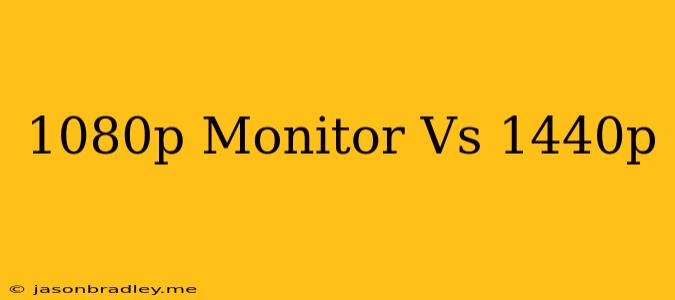1080p vs 1440p: Which Monitor Resolution Is Right for You?
Choosing the right monitor resolution can be a daunting task. Two popular resolutions are 1080p (1920 x 1080) and 1440p (2560 x 1440), each offering its own advantages and disadvantages. Understanding the differences between these two resolutions will help you make an informed decision based on your specific needs and budget.
1080p (Full HD)
Pros:
- Affordable: 1080p monitors are generally the most affordable option, making them a great choice for budget-conscious users.
- Wide availability: 1080p displays are widely available, offering a plethora of options in terms of size, features, and brands.
- High refresh rates and response times: Many 1080p monitors offer high refresh rates (144Hz or even 240Hz) and low response times, making them ideal for gamers.
- Works well with most hardware: Even older or less powerful gaming PCs can handle 1080p resolution smoothly.
Cons:
- Less detail: Compared to 1440p, 1080p offers less detail, especially noticeable in larger displays or when viewing content with a high pixel density.
- Pixelation at larger sizes: 1080p can appear pixelated on larger monitors, especially those exceeding 27 inches.
1440p (QHD)
Pros:
- Sharper image: 1440p displays offer significantly sharper and more detailed images than 1080p, resulting in a more immersive experience.
- Better for professional work: The extra detail makes 1440p monitors ideal for graphic design, video editing, or any work that involves intricate details.
- Future-proof: As technology advances, 1440p resolution is becoming increasingly popular, making it a more future-proof choice.
Cons:
- More expensive: 1440p monitors typically cost more than 1080p options.
- Higher hardware requirements: To achieve smooth performance at 1440p, you will need a more powerful gaming PC with a capable graphics card.
- Lower refresh rates: 1440p monitors often have lower refresh rates compared to 1080p, especially at the higher end of the price spectrum.
Choosing the Right Resolution:
Consider the following factors:
- Budget: 1080p monitors are more affordable, while 1440p monitors come with a higher price tag.
- Monitor size: Larger monitors benefit from higher resolutions like 1440p, while 1080p works well with smaller screens.
- Usage: If you're a gamer, a 1080p monitor with a high refresh rate might be ideal. For professional work or a more immersive experience, 1440p might be preferable.
- Hardware capabilities: Ensure your PC can handle the higher resolution of a 1440p monitor without compromising performance.
Ultimately, the best resolution for you depends on your individual needs and priorities. Whether you prioritize affordability, detail, or performance, consider the pros and cons of each resolution before making your decision.
